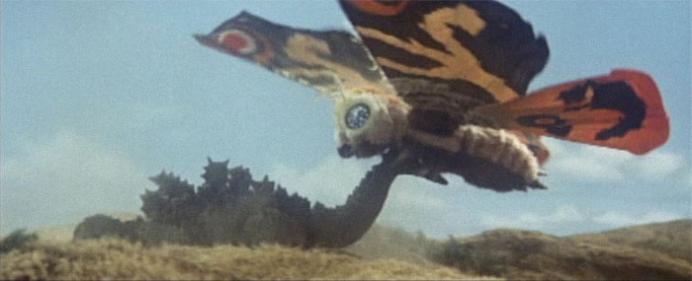Reviews
Mosura tai Gojira / Godzilla vs. the Thing
Ishirō Honda
Japan, 1964
Credits
Review by Sam Bett
Posted on 04 February 2013
Source Sony DVD
Categories The Compleat Godzilla
Mothra vs. Godzilla is the fourth film in the Godzilla franchise, the third to showcase a “monster vs. monster” scenario, the second to pit Godzilla against a celebrity monster, and the first film in which Godzilla shares the spotlight with a Toho Studios icon. Mothra first appeared in an eponymous Toho feature in 1961. Much like Godzilla in its uncut original, Mothra is a serious and ambitious art film with a skilled and varied cast, a symphonic theme, and an impressive supply of intricate architectural models for Mothra to topple with her 100-knot wing blasts. Its plot follows the paced suspense of lepidopteran metamorphosis: a huge sacred egg on a fallout-stricken Polynesian island hatches into a gargantuan larva that swims across the Pacific to Japan, where it snaps a radio tower in two, spins up a cocoon, and finally pupates into a winged monster that ravages Tokyo. Destruction is not the focus of the film, but its impending and devastating climax.
In contrast, Mothra vs. Godzilla is an elaborate justification for an all-star faceoff. The subject of the film, evident in the title, is neither Mothra nor Godzilla but their final showdown. Since both Godzilla and Mothra were fresh in the popular Japanese imagination at the time of its release, Mothra vs. Godzilla takes few pains to explain the provenance of its titular monsters. This time around, Mothra’s colossal egg floats without agency into Nagoya Harbor, a significant departure from the unflagging energy and vindictive purpose of the Mothra larva’s transpacific swim. Godzilla’s first appearance is even more sudden and desultory: thirty minutes into the film, with no prior introduction save the opening credits, his flailing reptilian tail bursts through a field of seaside rubble. For the next half hour, the action revolves around a series of military attacks on Godzilla by tank, fighter jet, and even “frontier missiles” (a kind of reappropriated anti-aircraft artillery deployed by paternal and obliging American military troops). The reporting team who guides us through the narrative drags Mothra back into the story by entreating her, via the intermediation of the film’s trademark Twin Fairies, to fend off Godzilla for the sake of humanity. With a nod of her dusty antennae Mothra assents, but we all know that the narrative impulse that secures the promised showdown is less humanitarian and more like “Let’s get ready to rumble.”
Mothra vs. Godzilla may lack the narrative and cinematographic complexity of its progenitors, but its threadbare storyline is not so much an obstacle as a fast-track to enjoyment. The fight scenes in the film are the obvious crowd-pleasers, and in this light the narrative is clement to its viewers by proceeding to exciting monster action as soon as context is established. In a manner perhaps unintended by Ishirō Honda when he directed Godzilla and Mothra, these first two movies established the reputation of each monster and a basic replicable narrative structure (hurricane > birth of monster > futile stratagem against monster > monster devastation) that permitted its winged or scaled progeny to romp and battle unencumbered in the world of kitsch and camp.
More The Compleat Godzilla
-

Godzilla
1954 -

Godzilla Raids Again
1955 -
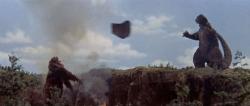
King Kong vs. Godzilla
1962 -

Mothra vs. Godzilla
1964 -

Ghidorah, the Three-Headed Monster
1964 -

Invasion of Astro-Monster
1965 -

Ebirah, Horror of the Deep
1966 -

Son of Godzilla
1967 -

Destroy All Monsters!
1968 -

All Monsters Attack
1969 -

Godzilla Vs. Hedorah
1971 -

Godzilla vs. Gigan
1972 -

Godzilla vs. Megalon
1973 -

Godzilla vs. Mechagodzilla
1974 -
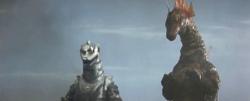
Terror of Mechagodzilla
1975 -

The Return of Godzilla
1984 -

Godzilla vs. Biollante
1989 -
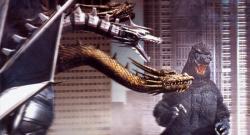
Godzilla vs. King Ghidorah
1991 -

Godzilla vs. Mothra
1992 -

Godzilla vs. Mechagodzilla
1993 -

Godzilla vs. SpaceGodzilla
1994 -

Godzilla vs. Destoroyah
1995 -

Godzilla 2000
1999 -
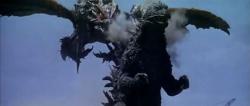
Godzilla vs. Megaguirus
2000 -
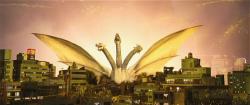
Godzilla, Mothra and King Ghidorah: Giant Monsters All-Out Attack
2001 -

Godzilla Against Mechagodzilla
2002 -

Godzilla: Tokyo S.O.S.
2003 -

Godzilla: Final Wars
2004
We don’t do comments anymore, but you may contact us here or find us on Twitter or Facebook.



